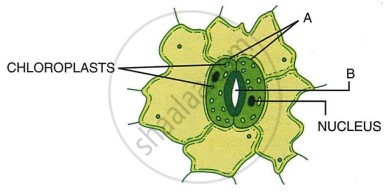Advertisements
Advertisements
प्रश्न
How will you differentiate the different types of transpiration?
उत्तर
There are three types of transpiration:
Stomatal transpiration: Loss of water from plants through stomata. It accounts for 90- 95% of the water transpired from leaves.
Cuticular transpiration: Loss of water in plants through the cuticle.
Lenticular transpiration: Loss of water from plants as vapour through the lenticels. The lenticels are tiny openings that protrude from the barks in woody stems and twigs as well as in other plant organs.
But transpiration is necessary for the following reasons.
- It creates a pull in leaf and stem.
- It creates an absorption force in roots.
- It is necessary for continuous supply of minerals.
- It regulates the temperature of the plant.
APPEARS IN
संबंधित प्रश्न
The figure below represents the vertical section of a leaf:

(i) Name the parts labeled 1 to 5.
(ii) What do the two arrows (dotted and solid) indicate in the day time and at night?
(iii) Could you add one more arrow in the figure? If yes, what for?
(iv) How many leaf veins have been shown in this section?
Give Technical Term
Opening found on the undersurface of the dorsiventral leaf.
Give Technical Term
Which side of the leaf has more stomata?
Mention the differences between stomatal and lenticular transpiration.
Guard cells help in regulating the ______.
The paper used to demonstrate unequal transpiration in a dicot leaf is ______.
Name the following:
The openings on the barks of trees through which transpiration occurs.
When guard cells are flaccid, the stoma must be ______.
Given below is the figure of a stoma. Study the same and answer the following questions:

- Label the guidelines A and B.
- Write the exact location of the above-mentioned structures.
- Mention one important role of structure A.
- Write three important roles for structure B.
- Redraw the same figure when structures A are in flaccid condition. When does the flaccid condition occur?
